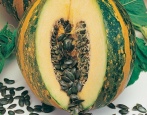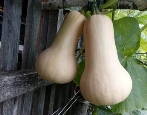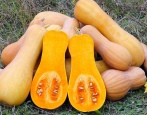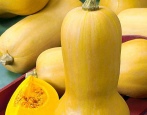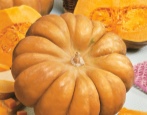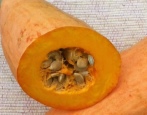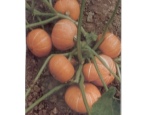
- Authors: USA
- Name synonyms: Big Max
- The form: rounded
- Weight, kg: from 4-6 to 18
- Coloration: pinkish orange
- Color of the pulp: orange
- Pulp (consistency): dense, juicy, fiber-breaking
- Taste: sweet
- Taste qualities: good ones
- Yield: high
Pumpkin variety Big Max (synonymous with the name Big Max) was bred by breeders from the United States. The variety was included in the register of breeding achievements approved for use on the territory of Russia in 2010, 4 years after the application was filed. The originator of the culture is Agrofirma Poisk LLC. Vegetable growers appreciate the Big Max pumpkin for its consistently high yield, excellent taste and good immunity to various diseases.
Description of the variety
The culture belongs to the large-fruited type of pumpkin. It is intended for outdoor cultivation. Bolshoi Max is a high-yielding mid-ripening variety of universal purpose, it is characterized by a high marketability of fruits. The culture is resistant to high and low air temperatures. Recommended for growing in the Central and Central Black Earth regions of Russia.
Characteristics of the appearance of plants and fruits
Pumpkin Big Max is a climbing plant. The leaves are large, light green in color. The fruits of this variety are characterized by a rounded shape and pinkish-orange color. They are large, the mass of one pumpkin usually ranges from 4-6 to 18 kg, some specimens can grow up to 40 kg. Fruits are segmented, with a smooth surface.
The seed nest is medium in size. Seeds are narrow elliptical, not very large. They are brownish in color with a white edge, rough, have a peel.
Purpose and taste
The flesh of the Big Max pumpkin is characterized by an orange color, which retains well after heat treatment. By consistency, the pulp is dense and juicy, of medium thickness, disintegrating into fibers.
The fruit has a very sweet taste and good taste. The Big Max variety is widely used in home cooking: juices, desserts are made from the pulp, and second courses are prepared. In this culture, the increased content of carotene: 2.8-4.5 mg per 100 g of raw material. It is ideal for the diet and diet of people with digestive problems, as it is very easy to digest. In addition, the fruits are perfectly stored for up to 70 days, ideally preserving the taste and presentation.
Ripening terms
This culture belongs to the middle late in terms of ripening. The period from germination to harvest is 120–130 days. Dates of mass harvesting fall on the end of August - September.
Yield
The variety Big Max is characterized by high yield. Average values are recorded as 7-8 kg / m 2. The crop is highly productive and ideal for industrial cultivation.
Growing and care
Pumpkin Big Max is easy to cultivate. When grown in seedlings, seeds are sown in special containers in late April - early May. Young plants are transplanted into open ground on a garden plot at the age of 21-25 days in late May - early June. Seeds can be sown directly into the soil no earlier than the end of May to a depth of 3-5 cm; several seeds are placed in the hole. It is recommended to follow the 100X100 cm planting pattern.
After the emergence of seedlings, it is necessary to thin them out. When 3-4 leaves appear, young pumpkins are covered with moist soil to form adventitious roots. The point of growth is pinched so that 5–7 leaves remain above the ovaries.If the fruit sets poorly in bad weather, artificial pollination should be carried out. To enhance the growth of pumpkins, it is necessary to limit their number to 3-4 pieces per plant.
The culture needs regular watering and loosening of the soil. Weeds should be removed in a timely manner. It is advisable to make complex fertilizing, especially in poor soil condition.
Requirements for soil and climatic conditions
Despite the fact that the Big Max variety is resistant to adverse weather conditions, you should choose a sunny place for growing it. The soil should be sandy loam or light loamy with a temperature of at least + 10 °. In autumn, it is recommended to add bird manure, lime or superphosphate to the ground in advance. If the soil is heavy, add compost or humus to it.
